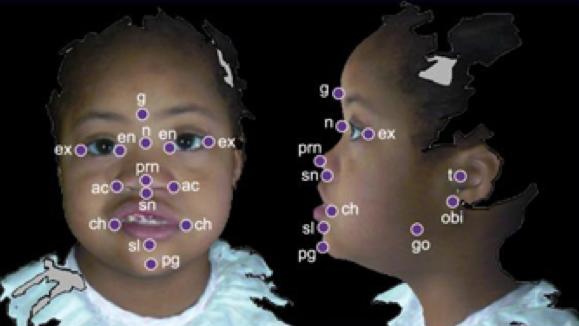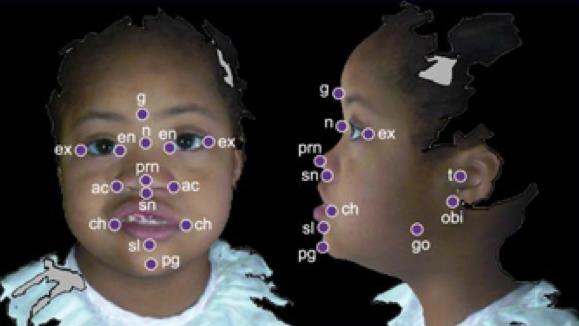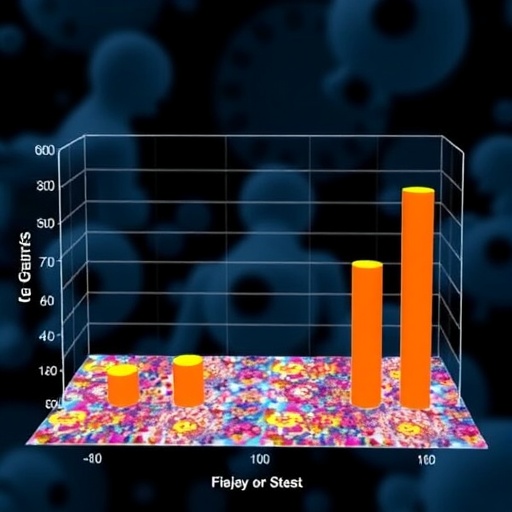
Credit: 3dMD
CLEMSON, South Carolina — Clemson University faculty have been awarded a grant from the National Institutes of Health to investigate the use of 3D imaging that could allow for quicker diagnosis of children with Phelan-McDermid syndrome, a rare genetic condition that causes intellectual and physical disabilities.
Katherine Weisensee, chair of Clemson's sociology, anthropology and criminal justice department, will focus the research on the facial characteristics that are often caused by the syndrome. These characteristics, which often include flattening of the face and a wide brow, have historically been the first signs that lead diagnosticians to identify the syndrome.
Due to the rarity of the syndrome, this diagnosis and associated genetic testing can have families waiting months or years for a conclusive answer. Technology that allows for detailed 3D scans of a large portion of the patient population could allow Weisensee and her fellow researchers to determine a quantitative "average" for these distinct characteristics, which would speed up diagnosis.
"These scans can give us a concrete idea of the difference between patients with the syndrome and the unaffected population," Weisensee said. "This would lead to a faster diagnosis for the child so that families can seek the interventions they need sooner."
Weisensee will utilize state-of-the-art image capture technology in which six cameras simultaneously capture photos of the patient's face every 1.5 milliseconds. Weisensee will then pick the most representative photos from the resulting string of images, and these images can then be rendered digitally to show an underlying network of data points between eye and nose or mouth and cheek, for example.
By coding facial landmarks and determining an "average" for characteristics across approximately 150 subjects — roughly a 10th of the documented population affected by the syndrome — researchers hope to trace the trajectory of the syndrome's effects and how that trajectory changes based on age, sex and ethnicity.
Weisensee is working with Kara Powder, assistant professor in Clemson's biological sciences department, to get a better sense of the relationship between facial development and gene disruption in the syndrome. These findings could have a bearing on gene therapy in the future.
"By defining the physical changes quantitatively and then charting the underlying genetic reasons for these changes, we can give physicians tools to recognize the syndrome faster and understand it more fully," Weisensee said. "Unfortunately, there is a shortage of professionals who can recognize it quickly, so we hope to provide a shortcut in this area for physicians."
Curtis Rogers, senior clinical geneticist at the Greenwood Genetic Center, is one of the few geneticists who has extensive experience with the syndrome. He has worked with the Phelan-McDermid Syndrome Foundation since its inception in 1998 and he said it is likely that he has seen more patients with the syndrome than any physician in the world.
In addition to understanding growth trajectory in patients, Rogers said documenting facial landmarks over time might allow physicians to predict the autism spectrum disorder and regression in developmental milestones associated with the syndrome. Between 50 and 85 percent of children with the syndrome develop autism spectrum disorder, and between 25 and 50 percent of children experience developmental regression.
However, the research would be worthwhile if only to achieve a better model for recognizing features that accompany the syndrome. Rogers said diagnosticians must "work their way down the diagnostic chain" to hone in on the syndrome, and this research might allow them to skip some links in that chain.
"Families are often stuck in limbo waiting for information, including what caused it and whether there is risk in a future pregnancy," Rogers said. "Considering it can take up to two years to get this diagnosis in some areas of the country, any project that allows us to get information to a family sooner is worthwhile. I say that not as a geneticist, but as a parent and grandparent."
Weisensee looks forward to applying her expertise of the skull and craniofacial symmetry in a way that will positively impact a specific population, but she also has a personal motivation. She has an uncle with a congenital disease, and although it has had a marked effect on his mental functioning, it has never been diagnosed.
"I feel that once you name a syndrome it helps people understand it and know what to expect," Weisensee said. "I think it would be great to be able to use my work to help shed some light on that mystery for families."
The syndrome is a rare genetic condition caused by a deletion or other structural change of a chromosome. The most common characteristics are intellectual disability of varying degrees, delayed or absent speech, symptoms of autism spectrum disorder, low muscle tone, motor delays and epilepsy.
The genetic changes that cause the syndrome vary from person to person and can occur randomly or be inherited from a parent who carries a related genetic change. There is currently no cure or treatment specifically for the syndrome, so early detection to manage symptoms effectively is of paramount importance to families.
###
Research reported in this publication was supported by the National Institute of Dental & Craniofacial Research of the National Institutes of Health under Award Number R03DE027497. The content is solely the responsibility of the authors and does not necessarily represent the official views of the National Institutes of Health.
Media Contact
Katherine Weisensee
[email protected]
864-656-3238
@researchcu
http://www.clemson.edu
Original Source
http://newsstand.clemson.edu/?p=162084





